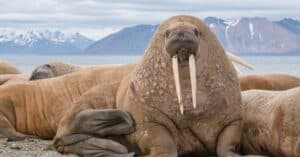What do you know about baby walruses? Unless you live in the Arctic region or happen to have a fondness for semi-aquatic mammals, you probably don’t know much about this amazing species. That’s okay. Baby walruses are so weirdly cute and smushy-looking, you will want to learn more about them as you look through these adorable photos. You might never have a chance to see a baby walrus in the wild, but you can learn all about them right now.
What Do You Call a Baby Walrus?
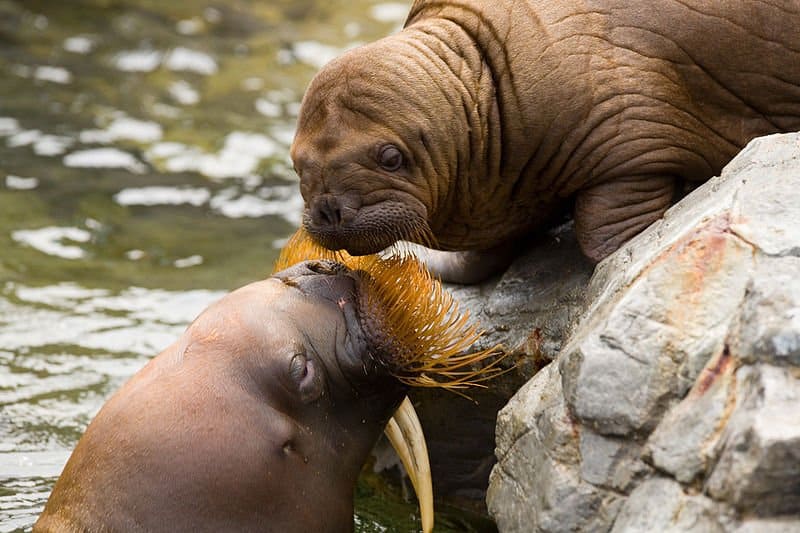
Baby walruses are called calves, or sometimes pups.
©Max Smith / CC0 – License
A baby walrus is called a calf, or sometimes a pup. You call an adult female walrus a cow, and an adult male a bull. A group of walruses, known as a herd, typically segregate themselves by sex. Female walruses and calves form herds separately from adult males, and they come together only during mating season. Herds can have anywhere from a few dozen to tens of thousands of individuals. The strength of the herd is the best protection against predators, and adult females will fight viciously to protect the calves.
When Do Walruses Give Birth?
Walruses usually mate in February, but mating can take place from January through March. The gestation period lasts about 15 to 16 months. This species utilizes delayed implantation or embryonic diapause, such that the fertilized blastocyst remains suspended until the conditions, including temperature and food supply, cause implantation to occur. Walrus cows usually give birth in the spring of the year after mating, during the migration season.
How Many Babies Do Walruses Have?
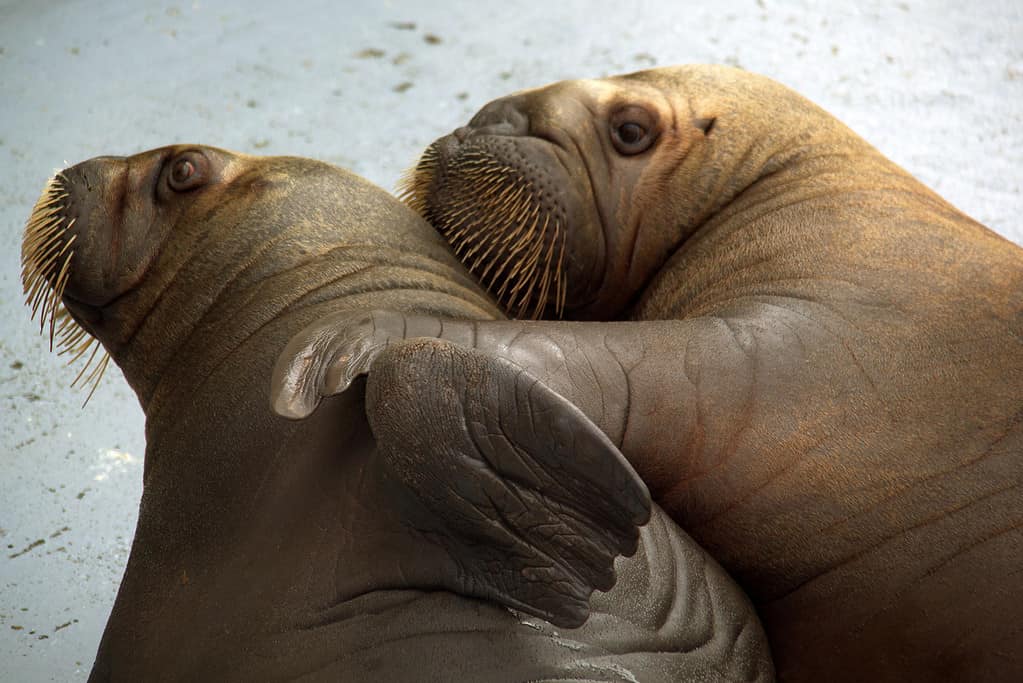
Walrus cows normally have just one calf at a time. Twins are rare.
©Sonia Hache/iStock via Getty Images
Walruses normally give birth to only one calf at a time. Very rarely, cows give birth to twins. The walrus cows give birth every two to four years. They nurse their offspring for a full two years, and the calves may stay with their mothers until they are about five years old. Female walruses become sexually mature at about that age or shortly thereafter. Males become sexually mature when they reach eight to ten years of age, though they may not be large or virile enough to compete for mates for a few more years after that.
How Big Is a Baby Walrus?
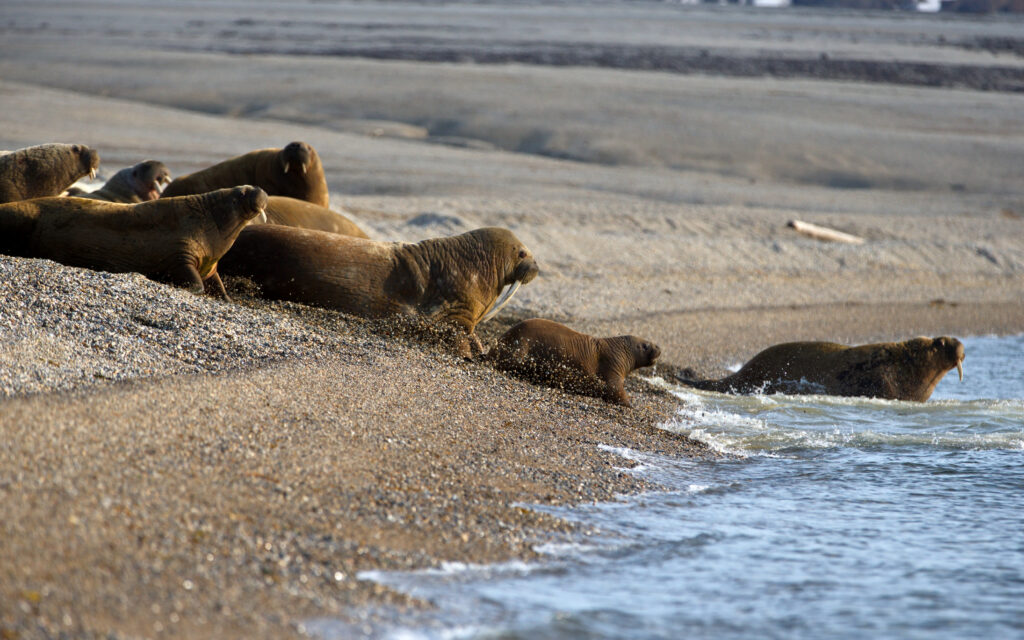
Baby walruses can swim not long after they are born. They stick close to their mother in and out of the water.
©Wirestock/iStock via Getty Images
Newborn baby walruses weigh between about 70 to 190 pounds. They range from a little over 3 feet to more than 4.5 feet in length when first born. Male walruses can reach average weights of approximately 2,000 to 3,700 pounds or more, with the Pacific walrus subspecies weighing much more than the Atlantic subspecies. Adult female walruses reach weights ranging from about 1,200 to 1,800 pounds. Adult walruses generally reach lengths between 7 to 12 feet, but some males have measured up to 16 feet long.
How Do Walruses Protect Their Young?
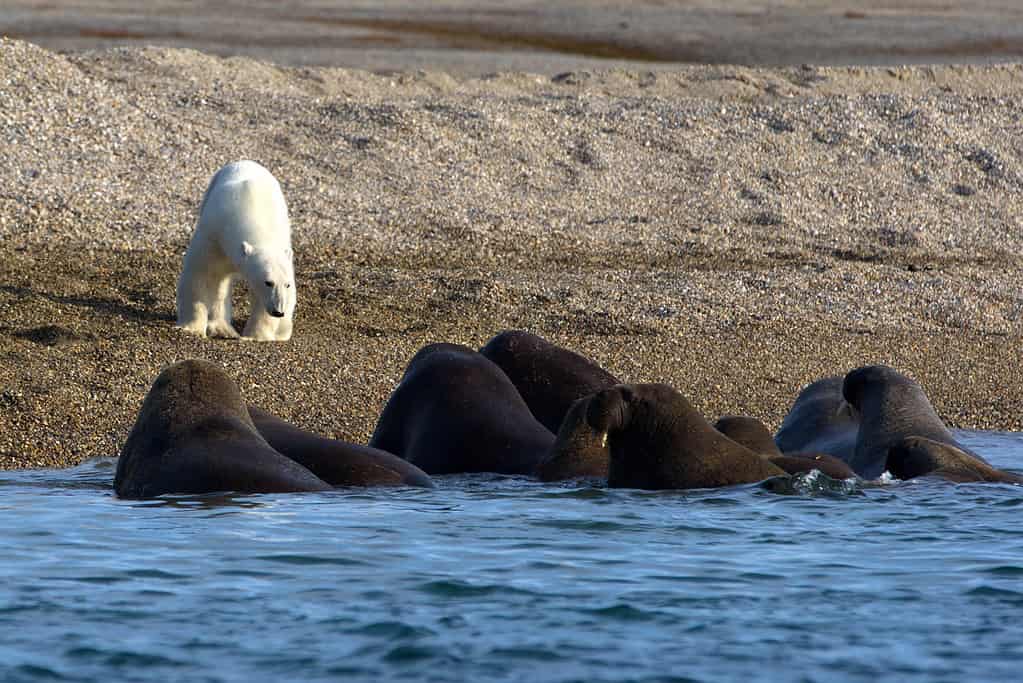
A
polar bear
might think twice about attacking a herd of walruses.
©Wirestock/iStock via Getty Images
Because walruses have a relatively low birth rate, they must work hard to protect their young. A baby walrus could fall prey to polar bears, orcas, large seals, sharks, or other predators. Mother walruses care for their young for an extended period. They form nursery herds where they work together to protect the babies. Mothers often guard their young calves by standing over them, keeping them directly between their front flippers while on land. When in the water, a baby walrus will often ride on its mother’s back.
Are Walruses Endangered?
Walruses are not yet endangered, but the IUCN Red List of Threatened Species categorizes them as Vulnerable. As of the most recent assessment, the total number of mature individuals was estimated at 112,500 with almost certain decline expected due to climate change. The population of the Pacific walrus subspecies currently outnumbers the Atlantic subspecies by an estimated 8 to 1.
Walruses are pinnipeds, belonging to a clade that includes seals and sea lions. These carnivorous animals use flippers to get around and live mainly in the oceans or seas. The walrus, Odobenus rosmarus, is the only surviving species in the family Odobenidae. That family once included more than a dozen other similar species, most with large tusks.
Does a Baby Walrus Have Tusks?

A baby walrus does not have tusks. They grow in slowly, emerging from the gums at 6 months.
©Ondrej Prosicky/iStock via Getty Images
Odobenus comes from Greek roots that mean tooth walker. Walruses pull their massive bodies up out of the water using their strong tusks. They also use their tusks to move around on the ice. These tusks are simply greatly enlarged canine teeth. Baby walruses do not have tusks when they are born. Their tusks emerge from the gums when they reach about 6 months of age. The tusks of both males and females poke out from beneath the upper lip by the time they reach 14 months.
What Do Baby Walruses Eat?
Baby walrus calves, like other mammals, drink milk from their mother. They depend on milk as their primary source of nutrition for two years or more. Calves usually nurse in the water, often while their mother forages for food on the ocean floor. When the baby walrus matures, it will use its vibrissae, the tough whiskers on its snout, to sense prey such as mollusks, crabs, sea cucumbers, and other organisms.
The photo featured at the top of this post is © thirtydry/iStock via Getty Images
Thank you for reading! Have some feedback for us? Contact the AZ Animals editorial team.




